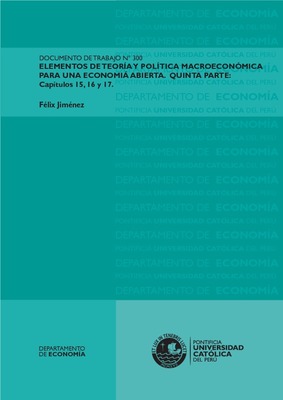| dc.contributor.author | Jiménez, Félix | |
| dc.date.accessioned | 2015-03-19T20:37:51Z | |
| dc.date.available | 2015-03-19T20:37:51Z | |
| dc.date.issued | 2010 | |
| dc.identifier.uri | http://repositorio.pucp.edu.pe/index/handle/123456789/46941 | |
| dc.description.abstract | La quinta parte, que consta de tres capítulos (15, 16 y 17), trata sobre la teoría del crecimiento de forma introductoria. El capítulo 15 presenta una breve revisión de la historia de la teoría del crecimiento económico. Luego, analiza los factores que determinan el comportamiento de largo plazo de la producción agregada y de la producción per cápita; asimismo, se desarrollan los principales conceptos de la teoría del crecimiento. El capítulo 16 estudia el modelo keynesiano de crecimiento de Harrod-Domar, y el modelo neoclásico de crecimiento de Solow. Estos modelos se desarrollaron desde fines de la década de los treinta y durante la segunda mitad del siglo XX. Ambos tipos de modelos suponen la existencia de equilibrio dinámico entre el ahorro y la inversión. El capítulo 17 es una introducción a la teoría del crecimiento endógeno. En los modelos de crecimiento neoclásicos puede haber crecimiento del producto per cápita a largo plazo sólo si se incorpora exógenamente el progreso técnico. La teoría del crecimiento endógeno sustituye los supuestos fundamentales de la teoría del crecimiento neoclásico para llegar a conclusiones y propuestas de política distintas. | es_ES |
| dc.description.abstract | The fifth part, which consists of three chapters (15, 16 y 17), presents an introduction to the theory of economic growth. The fifteenth chapter presents a brief history of economic growth theory. Then, it analyzes the factors that determine the long-term behavior of aggregate and per capita output, and the main concepts of the theory of economic growth. The sixteenth chapter analyzes the Keynesian Harrod-Domar growth model and the neoclassical Solow growth model. These models were developed between the late thirties and the second half of the twentieth century. Both models assume the existence of dynamic long run equilibrium between savings and investment. The seventeenth chapter is an introduction to the theory of endogenous growth. In neoclassical growth models the growth of per capita output is explained by exogenous technological progress. The endogenous growth theory replaces the fundamental assumptions of the neoclassical growth theory to reach different conclusions and policy proposals. | en_US |
| dc.language.iso | spa | es_ES |
| dc.publisher | Pontificia Universidad Católica del Perú. Departamento de Economía | es_ES |
| dc.relation.ispartof | urn:issn:2079-8466 | |
| dc.relation.ispartof | urn:issn:2079-8474 | |
| dc.relation.ispartofseries | Documento de Trabajo;300 | es_ES |
| dc.rights | info:eu-repo/semantics/openAccess | es_ES |
| dc.rights.uri | http://creativecommons.org/licenses/by-nc-nd/2.5/pe/ | * |
| dc.subject | Macroeconomía | es_ES |
| dc.subject | Teoría económica | es_ES |
| dc.subject | Política monetaria | es_ES |
| dc.subject | Política fiscal | es_ES |
| dc.title | Elementos de teoría y política macroeconómica para una economía abierta. Quinta parte: Capítulos 15, 16 y 17 | es_ES |
| dc.title.alternative | Elements of a macroeconomic theory and policy for an open economy. Fifth section. Chapters 15, 16 and 17 | en_US |
| dc.type | info:eu-repo/semantics/workingPaper | |
| dc.type.other | Documento de trabajo | |
| dc.subject.ocde | http://purl.org/pe-repo/ocde/ford#5.02.00 | |
| dc.publisher.country | PE | |
| renati.advisor.orcid | https://orcid.org/0000-0002-0585-238X | |


